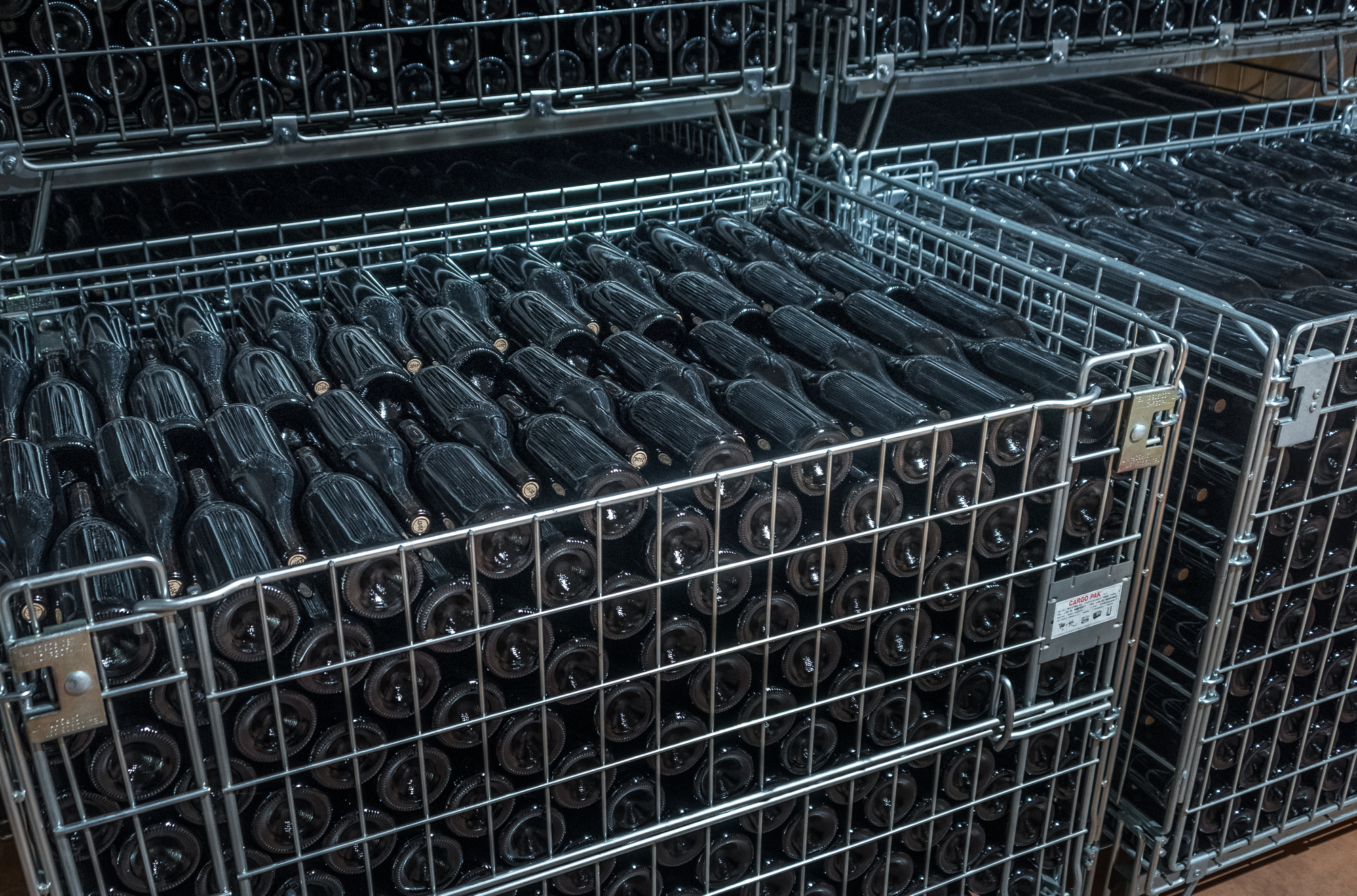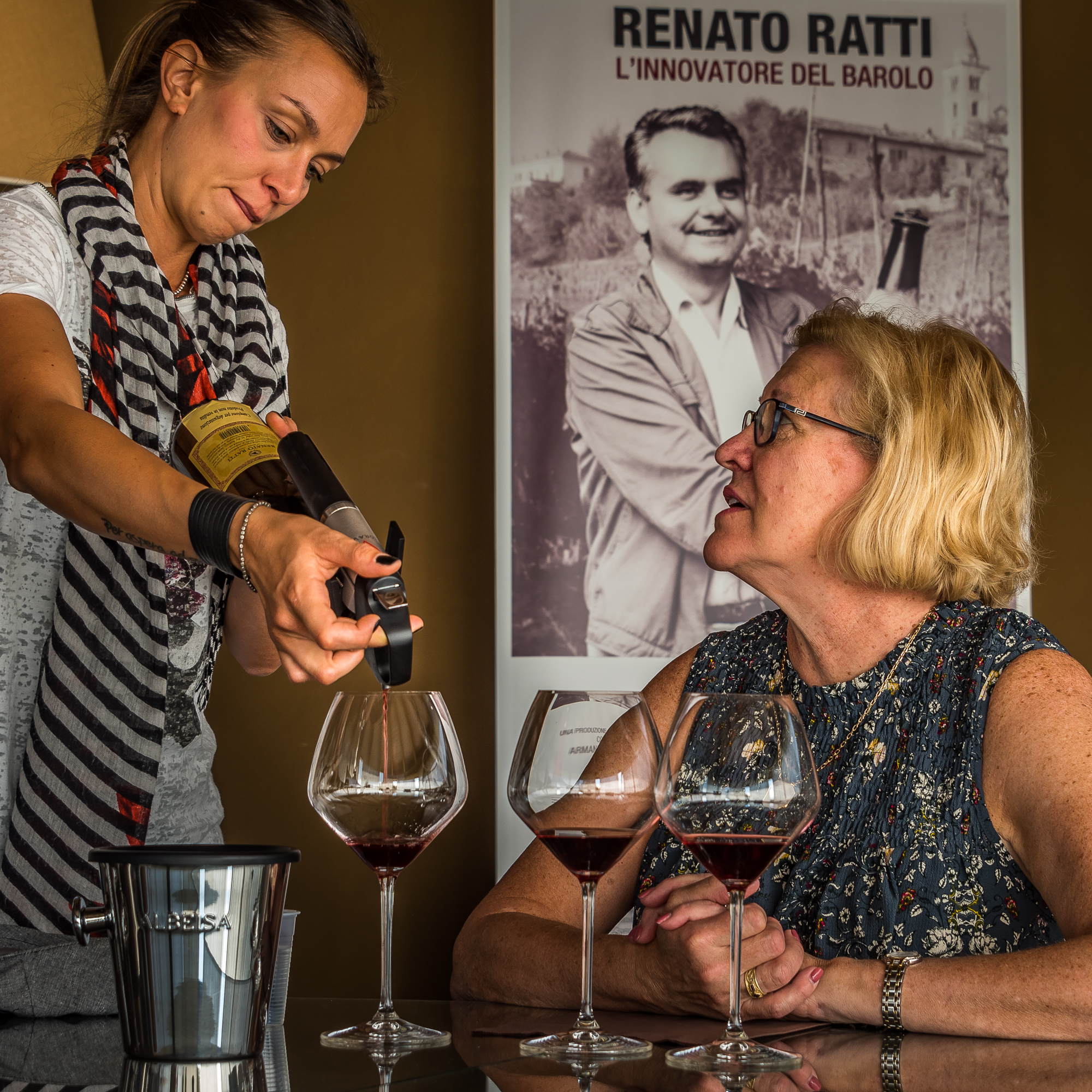This was the first winery stop on our most recent trip to Italy. We were drawn here because our most favorite and excellent dessert wine is Michele Chiarlo’s Nivole, Muscato d’Asti. Our kids have called it ‘liquid Heaven’.
This collage was created from Michele Chiarlo wine labels
“La Court is the perfect symbiosis between nature, the landscape and the efforts of man”
Our trip started with a visit to the Monferrato-area vineyards to see where the Barbera grapes are grown, and we then followed up with a wine tasting at Chiarlo’s winery.
So, where are we actually? We are in northern Italy in the region called Piemonte (Piedmont in English for some reason). Within the region of Piemonte is the Barolo area south of Alba, where Nebbiolo grapes are grown for Barolo. But right now, we are in the northeastern area known for the Barbera grape used in, non-other-than, Barbera wines. As we are close to the town of Asti, the Barbera wine produced here is known as Barbera d’Asti…and there are some other Barbera wine names associated here, too, as I’ll explain below.
The actors in this 3-act play are: my lovely wife, Ellen; sister- and brother-in-law Leslie and Craig Johnson, who are wonderful travel companions; and of course, me. And, there is a guest appearance by none other than Alberto, our host for the day.
Act One: The Vineyard of La Court
In this photo, you see the beautiful vineyards of La Court.
Photo from the Michele Chiarlo website
The copse of cypress dead-center in the photo were planted in the mid-1800s and are the symbol of the La Court vineyards. I use the term vineyards, instead of the singular vineyard, as there are eight different vineyard plots seen situated around the farmhouse at the upper-left of the photo. Each of the eight is planted in Barbera grape vines, but the grapes grown in the various vineyards are each handled and vinified differently to produce four different DCOG wines.
[I’ll cover what DCOG means in another article, but for today’s purpose, it means that the vineyards used in the four wines must face this direction or that, must have a certain slope, maximum production per acre, etc — all to protect the name and reputation of a particular Italian wine type, which in this case is Barbera d’Asti…think of a government-sponsored Good Housekeeping Seal of Approval…that does still exist, doesn’t it?]
For our visit, Alberto parked at the old farm house and we walked under the Le Orme archway toward that ancient copse of cypress.
You can see that the vineyard to the left of the path has recently been replanted with new vines
As we strolled, Alberto explained the layout of the vineyards and the wines produced from each of the areas that surrounded us.
Grapes in these vineyards are picked by hand, and not every cluster of grapes is worthy of being selected for harvest…like this cluster which was passed over during the previous week’s picking.
I’m kind of glad that these were of inferior quality, as we got to sample them right off the vine…and they were sweet and tasty.
At the time of our visit, workers were busy planting new vines in the northern-facing vineyard.
And that soil? Yes, it is typical of Italian vineyards in that it is high in mineral and low in organics. As their website suggests, it is called “astiane sands'’, and it consists of calcareous clay marl of sedimentary marine origin, with good presence of lime and sand, rich in microelements, in particular magnesium.”
This particular set of hillside vineyards is unique in Italy, as it is also known as the Art Park La Court. This art park is said to “celebrate the marriage of wine and art set within a landscape recognized as a UNESCO World Heritage Site.” Besides the archway under which we started our walk, there are other works of art throughout the vineyards.
The most interesting of the art works are the helmeted “wine row pole heads” found at the end of many of the rows of vines. Here are a smattering of these artistic accouterments, each decorated with a different species of animalia. As always, if you click on a thumbnail image, you will get a larger view.
The surrounding countryside is as picturesque as you would want as you visit an Italian vineyard.
Here is the bark of a 170-year old Italian cypress
The old farmhouse is a picturesque fixer-upper that I found to be artistically endearing. Here is my digitally-painted rendering
Act Two: The Winery
Michele Chiarlo’s Barbera winery is situated in the town of Calamandrana.
This is the winery where the Barbera grapes are vinified into the various Barbera-related wines produced by Michele Chiarlo.
We are now about 4 miles from the La Court vineyards where we learned of the land where the Barbera grapes are grown.
We drove by this sign three times before seeing and saying, “Oh, there it is!”.
Alberto took us through the wine-making process where grapes are pressed for their juice and then undergo fermentation in these stainless-steel tanks.
After fermentation, the wines are aged in barrels…some large and some small.
The barrel just below holds a Nizza wine. It will age in this barrel for 18 months. But a Nizza Riserva will barrel-age for 30 months.
The wording on the white label of ‘Atto a Nizza’ translates as ‘Nice Act’ in English
Though the wine making is an ancient art, the bottling is strictly modern, as you can see below.
And the wine that is being bottled at this moment? Why, it’s the Barbera d’Asti made with grapes from the just-visited Le Orme vineyards that we visited just moments before…and that we will be sampling in just a moment.
Act Three: The Tasting
Photo from the Michele Chiarlo website
I have to admit that this is my favorite part of a winery visit…the tasting.
Here is the tasting room, with the full line-up of wines that Michele Chiarlo produces.
Leslie is attentive to Alberto as he explains the intricacies of the wines, but I’m busy tasting this nice, white Arneis…and look at those lovely legs left on the glass because of the viscosity of the wine. This is the day that we fell in love with Arneis, as mentioned in a previous article here.
Also, we were able to taste the La Court Nizza Riserva, which had its grapes grown a the La Court vineyards just visited.
Though Nizza is made from the Barbera grape which, in this case, comes from vines planted in 1976, the overall vinification methods of this Nizza wine started recently in 2014. So it is a relatively new type of Barbera wine.
At the 50 acres we visited earlier in the day, only 7 acres are dedicated to the growing of the grapes destined for Nizza.
They recommend drinking Nizza with agnolotti with a wild rabbit sauce, tagliolini with porcini, roasted veal, or well-matured cheeses. It’s been awhile since we whipped up a wild rabbit sauce (like, never), so I would drink this with just about any Italian pasta. I mean, why not…right?
The next tasting was Le Orme, Barbera d’Asti. This is the wine which we had just observed being bottled.
This wine is readily available in the US market and we’ve had it at numerous restaurants.
The wine has been aged for 16 months, or “16 mesi” in Italian.
The color is ruby red with hues of violet. It is described as “elegant and intense, with notes of fresh mature red fruit, such as cherry and currant.” To me, it tastes like a nice red wine.
In case you want to be told what to drink this with, they suggest “Pasta with tomato, pizza, Livorno style fish, and white meat”. I’ll have a glass with my pizza, please.
At some point above, I suggested that one of the reasons we visited Michele Chiarlo was our familiarity with their dessert wine, Nivole.
Nivole is a Moscato d’Asti wine…meaning it comes from the white muscato grape and is from the Asti area of Piemonte. Asti is the number one place for the production of moscato-based dessert wines. And, Michele Chiarlo’s Nivole is recognized as the very best of the moscatos.
This wine has a brilliant straw color. After pressing the grape, the must is stored in a tank at 28°F and is followed by slow fermentation in an autoclave at a controlled temperature until the alcohol content is right at 5%. During this process, a part of the carbon dioxide developed during fermentation remains “entrapped”, giving the wine its mild, natural effervescence. Before bottling, it then undergoes a process of micro-filtration to give the wine its clarity, purity and stop any further fermentation of the yeasts. Many Moscato d’Asti wines are almost as effervescent as a prosecco, but Nivole’s bubbles are pleasantly subtle.
I’m not much on ferreting out notes of floral, tobacco, certain minerals and such in red wines, but I’m definitely into the velvety, apricot-like taste of Nivole.
Here is something that encouraged us to bring back several bottles of Nivole. In the USA, a 375ml bottle (half of a typical bottle of wine) costs almost $20. At Michele Chiarlo’s wine shop, a full size, 750ml bottle costs just over $10. And, being a sweet white wine, it keeps a good while in your refrigerator with the top screwed on.
The white muscat grapes for Nivole are grown up near Asti, and the lay of the land is very much different than that at La Court. In the photo below, you can see the vineyards for Michele Chiarlo’s Nivole, Moscato d’Asti. Just gorgeous, isn’t it?!
Photo from the Michele Chiarlo website
I know that you didn’t enjoy our visit to Michele Chiarlo as much as we did, and I’m very sorry about that. But amends can be made. Just go there for a visit yourself! I know you will enjoy it. And say ‘Hello’ to Alberto from the Johnsons and the Burketts.
Ciao for now,
Steve
p.s. Feel free to leave comments below!
























